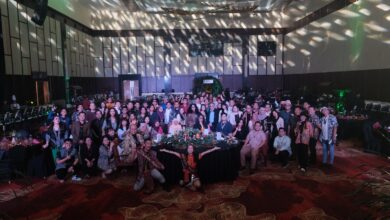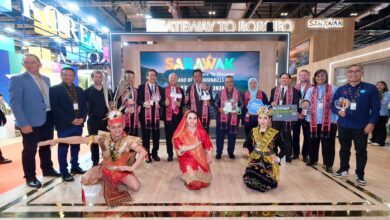Appreciating Nature’s Blessings at Kampung Peraya
By Rossalynn Ismail (Sarawak Tourism Board)
“People don’t take trips, trips take people.” ~ John Steinbeck
Here’s the deal – I am not an outdoor-sy kind of person. Trekking? Hiking? Rafting of all sorts? These terms are non-existent in my vocabulary.
Somehow life can hand you the most unexpected of opportunities though, as a work-trip landed me at the main gateway into Kampung Peraya, Padawan after about a 30-minute drive from Kuching City.

Situated 13km from the city, Kampung Peraya is home to villagers of the Bidayuh ethnicity, also known as Land Dayaks, that make up almost 10% of Sarawak’s population. The Bidayuhs are also the second biggest ethnic group in Sarawak after the Ibans.
Upon arrival at the Peraya Homestay at noon, its owner and also our guide Valentine Ritong welcomed us with a warm smile and proceeded to usher us to our ‘home’ for the night.
Okay, here comes the tricky part. To get to the homestay, you need to cross the Sirin River on a bridge made of bamboo. With every wary yet mindful step, we managed to cross it to reach Valentine’s 10-room longhouse.

The longhouse, surrounded by luscious greenery, lets its visitors have a glimpse of how the Bidayuhs of the past lived their lives – going up the stairs carved out of ‘kayu belian’ or ironwood (a rare timber native to Borneo) after a tiring day manning their crops and chilling at the open-spaced veranda whilst enjoying nature.

The circular rattan craftsmanship on the longhouse ceiling is somewhat like a visual metaphor for the Bidayuh tenacity in going about their everyday life. From an interior design perspective, the circular shapes of the rattan help create balance and harmony with the contrasting geometric lines of the longhouse. What is even more spectacular is that, according to Valentine, they were all made by hand.

Jungle Trekking to Muan Tabi Waterfall

After settling in at our designated rooms, we were served with delectable vegetable and chicken dishes for lunch. After a much-needed post-lunch break, we headed out to start the jungle trekking adventure to Muan Tabi waterfall. The starting point of the trail was an area with lines of pepper trees, with its ripening peppercorns.

Jungle trekking at Kampung Peraya is quite challenging for novice hikers. The trail’s unpredictable landscape takes you on a roller-coaster-like hiking experience – at some parts it is a straight walk on solid ground, then suddenly you reach a point where you need to climb a modest hill. Then, slowly and carefully, you carefully position your feet one step after another, making your way on the narrow-winded trails. Also, once in a while you will need to cross small streams and climb over fallen branches on the ground.

Our trekking journey took a little detour as Valentine brought us to a shed that housed a number of human skulls – their “enemies of the past”. Named as Panggah Jengga (Panggah House), it is a sacred site for the entire village. It is a known fact that in the olden times, the native tribes of Sarawak used to chop off the heads of their enemies and apart from being regarded as trophies, the skulls are also used for ritual purposes.
When asked why the skulls were white in colour, Valentine explained that after a warrior chopped off the enemy’s head, he would need to stay around the forest for several days and place the severed head in the river, thus resulting in the human flesh to be completely washed away and cleared out. Only after completing this ritual, could he return to their village and be welcomed grandiose-ly by the villagers. The headhunting ritual in Sarawak came to a stop when Sir James Brooke, the first White Rajah, put a ban on the practice in the 1800s.

For a non-hiker like me, the trekking indeed pushed my physical limits. We were almost at the end of our hike when Valentine, a master trekker who was way ahead of us, yelled out to announce that we had reached the waterfall. The sight of the secluded Muan Tabi waterfall was stunning, a glorious reward after an arduous trek. Valentine said the water is so pure from the top of the hill that it is safe to drink, and the waterfall’s calming pool seemed to beckon us to jump in and savour its invigorating freshness.

After more than 2 hours and about 6km covered, our trekking came to an end. Valentine and my trekking mates congratulated me for completing the journey, a feat that I would have never thought I could accomplish. Yes, it was grueling for me, but looking back and thinking of the beautiful surroundings and breath-taking wonders of nature I witnessed along the way, all the weariness and fatigue disappeared. Nature is the best healer they say, and after the trek, I concur wholeheartedly.

Bamboo Rafting Along Sirin River @ Kampung Peraya
Let me be honest. I was utterly nervous before going for the bamboo rafting activity but I was assured by our tour guide Valentine Ina that it would be an unforgettable experience – and he was right!
When we arrived at the starting point of the bamboo rafting activity at around 9.00am, we were welcomed by the scenic beauty of the shallow yet incredibly calm river. The line of bamboo trees with branches full of leaves along the riverbank created a majestic canopy, shielding us from the glaring sun.

While we were admiring the cool and clear atmosphere, the staff of Peraya Homestay were busy preparing our rafts. Ten rows of freshly-cut bamboo were lined-up evenly and tied with nylon strips. It may just be bamboo and nylon strips but one raft could carry up to 8 people! Looking at how skilled and fast they were at building them, one of the staff named Dennis said he had learned how to build rafts from when he was very young.

Once the bamboo rafts were ready, so were we, as we hopped on to them and sat on specially-made small chairs, designed by Valentine, that were attached to the raft. Valentine said he built them to ensure that his customers would be able to experience the journey comfortably. With a forceful nudge, the raft we were on began to glide along on the calm water. Along the journey, Dennis showcased his prowess in manoeuvring the raft using a single bamboo, navigating his way through a familiar route. For someone who has lived at Kampung Peraya all his life, Dennis knows every crook and corner of the river.

(Photo by Rossalynn Ismail)
For the majority of the journey, the river is so serene and the rafting so smooth that you feel completely relaxed. With the soothing sounds when the water hits the rocks, added with the lush green surroundings, I let myself be totally immersed in the therapeutic ambience, leaving all the concerns and worries of my everyday life behind.
Yet, due to the shallow waters, at certain points the raft gets stuck on big rocks which does not allow the raft to move forward. So, we had to get down from the raft and our paddlers pushed the raft to get it on its rightful course again. I watched all of this action closely and a thought crossed my mind – the entire bamboo rafting ride, ironically, is a reflection of life itself. Mostly we enjoy the good times, and when the going gets tough, we strive our very best to overcome the challenges that come our way.

As noon approached, of course lunch was on our minds. As part of the authentic Bidayuh village experience, Valentine and his team had a wonderful surprise for us. Without our realising, they had caught two fish and throughout the journey, had made several stops to gather bamboo shoots, daun ipis (leaves for cooking and eating), lemongrass, tepus (local wild ginger), tapioca leaves and many other fresh ingredients to be used in the cooking later. Once we reached the spot for lunch, Valentine and his team immediately got their cooking up and running. While waiting, me and my hiking mates took a dip in the cold shallow water.
Dennis showed us how to prepare and cook rice in bamboo. First, he laid out the cleaned rice on to a daun ipis, before folding it and slotting it into the bamboo, to be cooked over an open fire. Not just the rice, but all our lunch was cooked in bamboo tubes, a technique known locally as ‘pansoh’. What was on the menu? The ones cooked ‘ala pansoh was chicken with tempoyak (fermented durian), fish, bamboo shoots and paku uban (local fern), while the brinjals and chicken wings were grilled to perfection.

The result? An array of hot succulent, delicately flavoured dishes, served in the Bidayuh traditional ‘tipakuoh’ (serving bowls made from sturdy sago fronds) on one of the bamboo rafts. The food was a sight to behold, and was matched by its immaculate taste. What is more important to note is that not a single drop of oil was used in the cooking. Enjoying the freshest and healthiest food while sitting on a bamboo raft surrounded by the lush beauty of Sarawak’s nature? Something you must experience!

After lunch we proceeded to the next half of our journey, making our way to the finish line which is the Peraya Homestay site itself. Maybe because everyone was so full from lunch earlier, the ride was rather quiet. Knowing that the voyage was about to end, we were more attuned to our surroundings, focusing more on the wonders of nature that were engulfing us.

Finally, we arrived at our homestay, marking the end of our bamboo rafting experience, and also our stay at Kampung Peraya. The word ‘unforgettable’ is an understatement. This journey has indeed taught me that happiness and joy does not always be in malls or other urban dwellings, but may come in abundance when you become one with nature. Thanks to Valentine, his team and Melintan, we have learned to appreciate that the simplest things can be the key to the richest of experiences. So, for those seeking a moment of tranquillity and healing, I highly recommend Kampung Peraya as your destination of choice.

A group pose to mark the end of our bamboo rafting journey. Also in the photo is Valentine (standing, middle) with media friends from West Malaysia – Aiman (sitting with bucket hat), Timothy (giving peace sign) and Wan Xiang (behind Timothy). (Photo by Melintan Ina)
ENDS.




